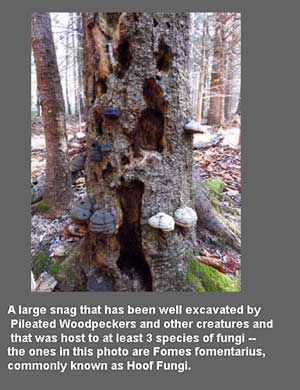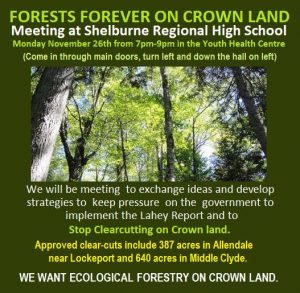“The health and well-being of the natural world around us is a very important part of who Nova Scotians are…The more activity that takes place in the forest without clarity on whether or not the shift that we have called for is going to be implemented, the more skepticism there will be… “ – Bill Lahey, author of the Report on the Independent Review.

Photo by Bev Wigney of a woodpecker tree on Hardwood Hill. View Bev Wigney’s Photo-essay of Life on Hardwood Hill, Annapolis Co..
In a recent CBC Interview, Professor Lahey, author of the Report on the Independent Review, expressed concern that “the more activity that takes place in the forest without clarity on whether or not the shift that we have called for is going to be implemented, the more skepticism there will be about whether or not that activity lines up with the approach that the report calls for.”
Listen to the full CBC interview (Nov 16, 2018)
View an Abbreviated Transcript below.
In todays Chronicle Herald, there is an article (behind a paywall) illustrating Prof. Lahey’s concern:
Residents concerned about forestry in Annapolis County
by Ian Fairclough
Residents near a proposed 20- hectare forestry operation in Annapolis County say the province should pause and take another look at the project.
Four generations of Randy Fredericks’ family have lived on a property half a kilometre away from the proposed harvest on an area known to residents of Tupperville as Hardwood Hill.
Fredericks says the harvest will encompass much of the 30 to 40 hectares of Hardwood Hill, and local residents are concerned about impacts to biodiversity and the local ecosystem.
The article cites a petition “written to the Department of Lands and Forestry to express the community’s concerns.” and goes on to summarize concerns expressed so elegantly earlier by Randy Fredericks. (View An eloquent appeal to save Hardwood Hill in Nova Scotia’s Annapolis Co. Post on NSFN, Nov 9, 2018.)
The article also highlights the inadequacies of the current system for notifying the public about “proposed” cuts on Crown lands*:
Fredericks says the harvest will encompass much of the 30 to 40 hectares of Hardwood Hill, and local residents are concerned about impacts to biodiversity and the local ecosystem. Marker tape has been placed in the area. Fredericks admits the property has been on the Department of Lands and Forestry’s harvest viewer web page “but I don’t think many people in the community even knew the harvest viewer existed.”
He said that meant no one knew about the proposal until Nov. 4, when someone came upon the plan by chance. The deadline for public comment on the proposed cut ended Oct. 29.
“There has been wide-spread mention that this kind of cut, or cuts in general, should be presented to the community in some other form that would be more apt to be seen by local people.”
He said sending notices to property owners within a certain distance of a proposed harvest “would be a way to let people know in more than just this one app.”
___________________
* Current Notification depends on citizens subscribing to notices and the having to check out precise locations of the harvests on a Harvest Plan Map Viewer, then if they want to go further, requesting the PTA (Pre-Treatment Assessments), and submitting comments by a prescribed date, which is 40 days from the time a harvest proposal is first posted.
“NDP Lands and Forestry critic Lisa Roberts was interviewed for the CH article and offered some particularly apt comments (bolding is mine):
Thanks Prof Lahey, Thanks Randy Fredericks and Bev Wigney, Thanks Lisa Roberts for expressing your concerns about ‘the health and well-being of the natural world around us’. I hope the Premier shares them.[She] said from everything she had heard about Hardwood Hill, “it is a special place that is valued by residents who live near it for a host of different reasons.”
She said that from what she has read in the Lahey Report on forest practices in the province, “it’s fair to to say the Department of Lands and Forestry has not adequately been accounting for the different values of Crown land when cuts are being approved.” She said the Lahey Report “clearly stated that we are not doing an adequate job right now on assessing the impact of cutting or harvesting on wildlife.”
That an area considered as special by local residents could be substantially harvested right now, “when we already know (from the Lahey Report) that the current process of the Department of Lands and Forestry is inadequate, is very alarming,” Roberts said.
She likened harvesting approvals being sought and approved now to builders rushing to put up new buildings before a new municipal planning strategy is implemented. “We should just press pause on special pieces of Crown land that have these values of multi-age species mix, that have a known history of being important for wildlife.”
———-
Many are wondering why the province hasn’t yet responded to an independent forestry review, released in August (audio)
Portia Clark interviews Prof Lahey on CBC Information Morning, Nov 16, 2018. “Checking in with William Lahey. We ask the author of the Independent Review of Forest Practices in Nova Scotia why he thinks so many people are interested in his report.”
ABBREVIATED TRANSCRIPT (NSFN)
PC: Portia Clark
BL: Bill Lahey
PC: The province asked Professor Williams from the University of Kings College to look into the provinces forestry practises … the Review came out this past August with recommendations on way to ways to improve forestry practises, keeping in mind economic social and environmental issues. The province hasn’t responded yet
I talked to Professor Lahey yesterday
Give us a refresher? What’s the overarching theme of your report?
BL: The theme is the need for a new paradigm, a new of thinking, of how we conduct forestry in the province that I call ecological forestry by virtue of the fact that it gives priority to the protection of ecosystems and biodiversity rather than thinking of those as values that can be traded off against other values such as economic ones…
The report recommended implementation of a triad model of ecological forestry and the triad model would require as much forest as possible to be managed either exclusively for conservation, or for providing timber for the forest industry [but] the vast majority of the forest [would be] in a third category where it would be managed for a combination of conservation and production objectives…
The report called for the full implementation of the Triad Model on Crown land as quickly as possible and that would result in a significant majority of Crown land being either managed purely for conservation or being managed for a combination of production and conservation objectives with some Crown land in the leg with intensive production including clearcutting.
PC: People are still talking about the Report in the 3 months since it came out, in part perhaps because we are still waiting for a response from the government. What do make of all the interest?
BL: I think it speaks to the widespread interest in our forests and nature more generally; the health and well-being of the natural world around us is a very important part of who Nova Scotians are. Nova Scotians care…. [they have] concern about how forestry is being practiced…[it also speaks to] the success that our review in laying out clear concepts and principles that people can identify with and that provide some reassurance that there is a way to manage the forest that does a better job of protecting the aspects of the natural world that people care about while at the same time ensuring that we have a prosperous forest industry….
PC:. It’s been 3 months since your report came out, how much time did you expect it would take for the government to respond?
BL:… I hope the length of time the government is taking shows that it is thinking carefully and taking a deliberative approach… that it will take a holistic approach to implementing the report, and that its decision reflects true commitment to implementing the report on a sustainable basis…the changes that the report calls for are changes that can only be implementing by taking sustained action and direction over may years…
PC: Have you had any contact or calls from the departments?
Lahey: In the immediate aftermath of the release of the report…I spent time briefing officials…I had good and encouraging dialogue… I took all of that as encouraging but since then…I have left them to do their analyses and there has not been further interaction since those early days.
PC: How urgent would you say it is that the province moves quickly…?
BL:..Obviously you would like to see the report endorsed.. ASAP…The longer the decision- -making process takes, the more people will be concerned that actions being taken in the meantime will make the job that has to be done all the more difficult…also [there is concern] that the delay is so that actions could be taken that would not be consistent with those that would be taken if the report is fully implemented.
On the other side, we want not just a decision from the government, but a well-considered decision that will be a foundation for sustained implementation of the report over many years, not just a short term approach… I am anxious to see what the government will do.
PC: Some people are concerned…that significantly more Crown land could be cut while we are waiting for the government to respond. How much do you share those concerns…?
BL…the more activity that takes place in the forest without clarity on whether or not the shift that we have called for is going to be implemented, the more skepticism there will be
about whether or not that activity lines up with the approach that the report calls for.
PC: WestFor [has been given a ] license for another year, what do you think about that?
BL: The Report acknowledges that the industry is facing a significant transition on Crown land in particular If the changes called for are implemented. So for example in the Western Region, we called for a land-use planning process for Crown and… there are soil conditions that are unique to that part of the province… but at the same time the needs of the mills in the western part of the province need to be respected as the transition takes place.. so I am not concerned that licenses have been extended, but… it would be better if in addition to doing that, the government was in a position to communicate their decision on adoption and implementation of the report on a holistic basis… that would give people more confidence that these two things an consistent and aligned with each other.
Q. You say Nova Scotia’s Endangered Species Act has to be fully and rigorously implemented and that is not the case right now; why do you say that?
BL: There just isn’t the activity under the legislation that is called for to protect endangered species and habitat.. you can’t protect endangered species simply by administering the Endangered Species Act… the habitat necessary for specific endangered species depends on the health and well-being of broader ecosystems and biodiversity.. hence the call for more action on Endangered Species is matched by the call for a more ecological approach on how we conduct forestry on the broader landscape.
——

